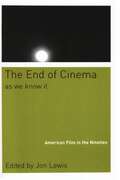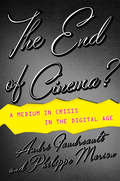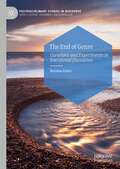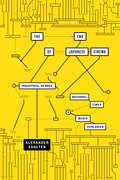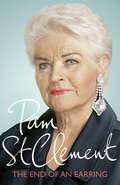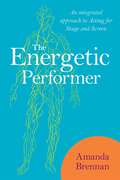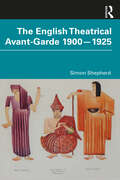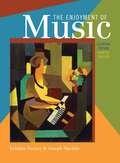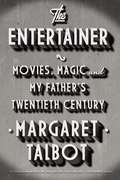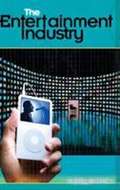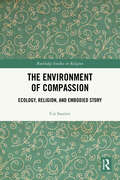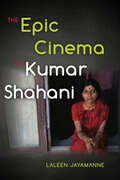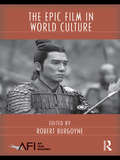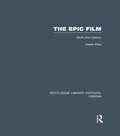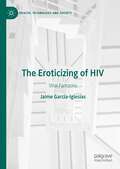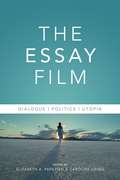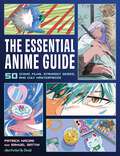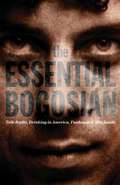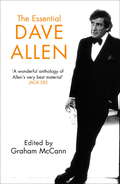- Table View
- List View
The End Of Cinema As We Know It: American Film in the Nineties
by Jon LewisThirty-four essays that take a serious look at the state of modern cinemaAlmost half a century ago, Jean-Luc Godard famously remarked, "I await the end of cinema with optimism." Lots of us have been waiting forand wondering aboutthis prophecy ever since. The way films are made and exhibited has changed significantly. Films, some of which are not exactly "films" anymore, can now be projected in a wide variety of wayson screens in revamped high tech theaters, on big, high-resolution TVs, on little screens in minivans and laptops. But with all this new gear, all these new ways of viewing films, are we necessarily getting different, better movies? The thirty-four brief essays in The End of Cinema as We Know It attend a variety of topics, from film censorship and preservation to the changing structure and status of independent cinemafrom the continued importance of celebrity and stardom to the sudden importance of alternative video. While many of the contributors explore in detail the pictures that captured the attention of the nineties film audience, such as Jurassic Park, Eyes Wide Shut, South Park: Bigger, Longer and Uncut, The Wedding Banquet, The Matrix, Independence Day, Gods and Monsters, The Nutty Professor, and Kids, several essays consider works that fall outside the category of film as it is conventionally definedthe home "movie" of Pamela Anderson and Tommy Lee's honeymoon and the amateur video of the LAPD beating of Rodney King. Examining key films and filmmakers, the corporate players and industry trends, film styles and audio-visual technologies, the contributors to this volume spell out the end of cinema in terms of irony, cynicism and exhaustion, religious fundamentalism and fanaticism, and the decline of what we once used to call film culture. Contributors include: Paul Arthur, Wheeler Winston Dixon, Thomas Doherty, Thomas Elsaesser, Krin Gabbard, Henry Giroux, Heather Hendershot, Jan-Christopher Hook, Alexandra Juhasz, Charles Keil, Chuck Klienhans, Jon Lewis, Eric S. Mallin, Laura U. Marks, Kathleen McHugh, Pat Mellencamp, Jerry Mosher, Hamid Naficy, Chon Noriega, Dana Polan, Murray Pomerance, Hillary Radner, Ralph E. Rodriguez, R.L. Rutsky, James Schamus, Christopher Sharrett, David Shumway, Robert Sklar, Murray Smith, Marita Sturken, Imre Szeman, Frank P. Tomasulo, Maureen Turim, Justin Wyatt, and Elizabeth Young.
The End of Cinema?
by André Gaudreault Timothy Barnard Philippe MarionIs a film watched on a video screen still cinema? Have digital compositing, motion capture, and other advanced technologies remade or obliterated the craft? Rooted in their hypothesis of the "double birth of media," André Gaudreault and Philippe Marion take a positive look at cinema's ongoing digital revolution and reaffirm its central place in a rapidly expanding media landscape.The authors begin with an overview of the extreme positions held by opposing camps in the debate over cinema: the "digitalphobes" who lament the implosion of cinema and the "digitalphiles" who celebrate its new, vital incarnation. Throughout, they remind readers that cinema has never been a static medium but a series of processes and transformations powering a dynamic art. From their perspective, the digital revolution is the eighth major crisis in the history of motion pictures, with more disruptions to come. Brokering a peace among all sides, Gaudreault and Marion emphasize the cultural practice of cinema over rigid claims on its identity, moving toward a common conception of cinema to better understand where it is headed next.
The End of Cinema?: A Medium in Crisis in the Digital Age (Film and Culture Series)
by André Gaudreault Philippe MarionIs a film watched on a video screen still cinema? Have digital compositing, motion capture, and other advanced technologies remade or obliterated the craft? Rooted in their hypothesis of the "double birth of media," André Gaudreault and Philippe Marion take a positive look at cinema's ongoing digital revolution and reaffirm its central place in a rapidly expanding media landscape.The authors begin with an overview of the extreme positions held by opposing camps in the debate over cinema: the "digitalphobes" who lament the implosion of cinema and the "digitalphiles" who celebrate its new, vital incarnation. Throughout, they remind readers that cinema has never been a static medium but a series of processes and transformations powering a dynamic art. From their perspective, the digital revolution is the eighth major crisis in the history of motion pictures, with more disruptions to come. Brokering a peace among all sides, Gaudreault and Marion emphasize the cultural practice of cinema over rigid claims on its identity, moving toward a common conception of cinema to better understand where it is headed next.
The End of Genre: Curations and Experiments in Intentional Discourses (Postdisciplinary Studies in Discourse)
by Brenton FaberThis book explores early new critical debates about intention, tracing how and why intention was dismissed across much humanities scholarship, and how it can be revisited and made relevant as a key formative, evaluative, and ethical concept. The author argues that the academic disinterest in intention occurred simultaneously as genre criticism and later the rhetorical interest in genre came into its own. Genre became a way to simultaneously elide and naturalize intention. The book elaborates on the pedagogical, ethical, and empirical consequences naturalizing intention through genre has had for rhetorical studies and it offers a new term, “curations” to identify discursive forms, actions, and intentions working simultaneously. Finally, he also examines the gap between the humanities and STEM fields and shows specific ways scientists and engineers have called for the humanities to become more invested in intention as both a critical and an operational concept. This book will be of interest to students and scholars of discourse studies and critical discourse analysis, rhetoric and professional communication, including those in fields such as medicine, engineering, STS and business studies.
The End of Japanese Cinema: Industrial Genres, National Times, and Media Ecologies
by Alexander ZahltenIn The End of Japanese Cinema Alexander Zahlten moves film theory beyond the confines of film itself, attending to the emergence of new kinds of aesthetics, politics, temporalities, and understandings of film and media. He traces the evolution of a new media ecology through deep historical analyses of the Japanese film industry from the 1960s to the 2000s. Zahlten focuses on three popular industrial genres: Pink Film (independently distributed softcore pornographic films), Kadokawa (big-budget productions as part of a transmedia strategy), and V-Cinema (direct-to-video films). He examines the conditions of these films' production to demonstrate how the media industry itself becomes part of the politics of the media text and to highlight the complex negotiation between media and politics, culture, and identity in Japan. Zahlten points to a different history of film, one in which a once-powerful film industry transformed into becoming only one component within a complex media-mix ecology. In so doing, Zahlten opens new paths for uncovering similar broad processes in other large media societies. A Study of the Weatherhead East Asian Institute, Columbia University
The End of an Earring
by Pam St ClementIn January 2012, one of EastEnders' longest-serving and best-loved characters breathed her last when Pat Butcher succumbed to cancer. Her departure from the show gave actress Pam St Clement time to reflect, not only on almost 26 years playing a role that she loved, but also on her whole life.Pam's mother died when she was a baby, leaving her with a father whose life didn't really have space for a child. What followed was an itinerant childhood, with various stepmothers and foster families, before an advertisement in The Lady took 11-year-old Pamela to the farm in Devon that was to become her true home, with the 'aunts' who became her surrogate parents. Time on the farm at Dartmoor, where she discovered her love of animals, alternated with life at The Warren boarding school in West Sussex, where she discovered her passion for acting.On leaving school, Pam was unsure of what direction to take but gradually realised that acting was what she wanted to do with her life. So, in 1966, Pam took up a place at drama school. Pam settled in London and worked on stage and television throughout the sixties and seventies, before her first appearance on EastEnders in 1986 and the offer of a permanent role a few months later.This memoir is far more than simply an actor's tale. Quite apart from her fascinating and unique childhood, Pam also recalls her involvement in the women's movement of the 1970s, her lifelong love of animals and the worries about her weight that have dogged her since her teenage years. It is also a tribute to Pat Butcher, for whom Pam retains a huge affection.This incredibly warm memoir reveals the woman behind the popular EastEnders' character, a woman who, apart perhaps from her earrings, couldn't be more different from Pat.
The End of an Earring
by Pam St ClementIn January 2012, one of EastEnders' longest-serving and best-loved characters breathed her last when Pat Butcher succumbed to cancer. Her departure from the show gave actress Pam St Clement time to reflect, not only on almost 26 years playing a role that she loved, but also on her whole life.Pam's mother died when she was a baby, leaving her with a father whose life didn't really have space for a child. What followed was an itinerant childhood, with various stepmothers and foster families, before an advertisement in The Lady took 11-year-old Pamela to the farm in Devon that was to become her true home, with the 'aunts' who became her surrogate parents. Time on the farm at Dartmoor, where she discovered her love of animals, alternated with life at The Warren boarding school in West Sussex, where she discovered her passion for acting.On leaving school, Pam was unsure of what direction to take but gradually realised that acting was what she wanted to do with her life. So, in 1966, Pam took up a place at drama school. Pam settled in London and worked on stage and television throughout the sixties and seventies, before her first appearance on EastEnders in 1986 and the offer of a permanent role a few months later.This memoir is far more than simply an actor's tale. Quite apart from her fascinating and unique childhood, Pam also recalls her involvement in the women's movement of the 1970s, her lifelong love of animals and the worries about her weight that have dogged her since her teenage years. It is also a tribute to Pat Butcher, for whom Pam retains a huge affection.This incredibly warm memoir reveals the woman behind the popular EastEnders' character, a woman who, apart perhaps from her earrings, couldn't be more different from Pat.
The Energetic Performer: An Integrated Approach to Acting for Stage and Screen
by Amanda BrennanA new approach to actor training by a senior teacher, this illustrated manual shows how to use the body to produce rich, varied and truthful performances. The approach, rooted in the Michael Chekhov Technique, integrates ancient Qigong knowledge with somatic psychology and western actor training methods to identify the links between physical shape, emotion and feeling in performance. Supporting and illustrating the text, extensive practical exercises developed through actor training classes provide techniques to tune and adapt the body in preparation for creative work. This book will enhance your understanding of the actor's craft, offering the opportunity to grow and advance your pre-existing skills. Warm ups and sequences of exercises will enable you to implement and fully understand this innovative approach. All of the work can be applied to live and screen performances.
The English Theatrical Avant-Garde 1900-1925
by Simon ShepherdThe English Theatrical Avant-Garde, 1900–1925 unearths an extensive range of hitherto forgotten or ignored theatre practices. In doing so it reveals some of the well-known figures of the early twentieth-century English theatre in a strikingly new light. It fluently describes an intensity of innovation and experiment that together made the Edwardian theatre rather more radical, and rather more queer, than we’ve ever thought. Where the majority of writing on the early twentieth-century theatrical avant-garde is concerned with European movements and experiments, English activity of the period is often seen as parochial and conservative – mainly realism and issues-based drama. This book presents a new model of how avant-gardes might work; a model based not on masculine individualism but on communal inclusion. In describing this fascinating material, the author introduces us to many new figures and shows familiar ones in different ways: there’s Florence Farr, independent woman; Bob Trevelyan, radical pacifist and music drama pioneer; Granville Barker doing fairy plays while de-dramatising drama; Laurence Housman, socialist, homosexual, scripting St Francis; and the oddly modern J.M. Barrie. Together they made theatre practices rich in their diversity but consistent in their attempt to be new, producing a theatrical avant-garde unlike any other. This is a vital and indispensable new study for scholars and students of early twentieth-century theatre in England and beyond.
The Enjoyment of Music: An Introduction to Perceptive Listening (11th Edition, Shorter Version)
by Joseph Machlis Kristine ForneyEasy to read, easy to teach, The Enjoyment of Music has been the most trusted introduction to music for over five decades. The Eleventh Edition reflects how today's students learn, listen to, and live with music. With an accessible, student-friendly treatment of the subject, it emphasizes context to show how music fits in the everyday lives of people throughout history, and connects culture, performance, and technology to the lives of students today. The new edition features a streamlined and memorable narrative, more cultural and historical context, and in-text features that encourage and develop critical thinking skills.
The Entertainer
by Margaret TalbotUsing the life and career of her father, an early Hollywood actor, New Yorker writer Margaret Talbot tells the thrilling story of the rise of popular culture through a transfixing personal lens. The arc of Lyle Talbot’s career is in fact the story of American entertainment. Born in 1902, Lyle left his home in small-town Nebraska in 1918 to join a traveling carnival. From there he became a magician’s assistant, an actor in a traveling theater troupe, a romantic lead in early talkies, then an actor in major Warner Bros. pictures with stars such as Humphrey Bogart and Carole Lombard, then an actor in cult B movies, and finally a part of the advent of television, with regular roles on The Adventures of Ozzie and Harriet and Leave It to Beaver. Ultimately, his career spanned the entire trajectory of the industry. In her captivating, impeccably researched narrative—a charmed combination of Hollywood history, social history, and family memoir—Margaret Talbot conjures warmth and nostalgia for those earlier eras of ’10s and ’20s small-town America, ’30s and ’40s Hollywood. She transports us to an alluring time, simpler but also exciting, and illustrates the changing face of her father’s America, all while telling the story of mass entertainment across the first half of the twentieth century. .
The Entertainment Industry
by Michael J. HaupertAimed at students and general readers, this text traces the historical evolution of entertainment as an economic entity in 20th-century America. The volume is organized roughly chronologically, and six representative types of entertainment are examined: vaudeville, recorded sound, movies, radio, television, and spectator sports. In the final chapter, Haupert (economics, U. of Wisconsin-LaCrosse) profiles 15 individuals who had a profound effect on the entertainment industry. Annotation ©2006 Book News, Inc. , Portland, OR (booknews. com)
The Environment of Compassion: Ecology, Religion, and Embodied Story (Routledge Studies in Religion)
by Cia SautterThe Environment of Compassion explores questions of what it means to be in relationship to nature, if and how it is a religious experience, and how understanding humans as part of nature alters theology. The book offers a performance perspective that looks at ritual, dance, and theatre as a means of presenting discussion of sacred values in the public realm. The premise is that performance may serve as an effective means for developing human sacred values that recognize the more-than-human world, as it increases intersubjective awareness to address issues of social and environmental justice. The author investigates religion and theatre as a means of better understanding how eco-consciousness requires an aesthetic of the sacred. Rather than separate religion, culture, and nature, the book presents an aesthetic looking at the relationship between them. It considers how an embodied theatrical story might develop an inclusive community of compassion. Weaving the chapters together is an account of The Garden: A Refuge, an eco-centered play based on the biblical book of Job. Ecotheology, aesthetics, and embodiment theories are examined throughout, with scholarship and examples drawn largely from the Jewish tradition. The book is relevant to scholars of religion and theology, particularly those with an interest in the environment, as well as theatre, dance, and performance studies.
The Epic Cinema of Kumar Shahani
by Laleen JayamanneThe Epic Cinema of Kumar Shahani examines the major works of leading Indian film director Kumar Shahani and explores the reaches of modernist film aesthetics in its international form. More than an auteur study, Laleen Jayamanne approaches Shahani's oeuvre conceptually, as films that reveal cinema's synesthetic capabilities. As the author illustrates, Shahani's cinematic project entails a modern reformulation of the ancient oral tradition of epic narration and performance in order to address the contemporary world, establishing a new cinematic expression. As evidenced by his films, constructing cinematic history entails more than an archival project of retrieval and is a living history of the present, which can intervene in the current moment through sensory experiences.
The Epic Film in World Culture (AFI Film Readers)
by Robert BurgoyneWith the recent release of spectacular blockbuster films from Gladiator to The Lord of the Rings trilogy, the epic has once again become a major form in contemporary cinema. This new volume in the AFI Film Readers series explores the rebirth of the epic film genre in the contemporary period, a period marked by heightened and conflicting appeals to national, ethnic, and religious belonging.The orginal essays in this volume explore the tension between the evolving global context of film production and reception and the particular provenance of the epic as an expression of national mythology and aspirations, challenging our understanding of epics produced in the present as well as our perception of epic films from the past. The contributors will explore new critical approaches to contemporary as well as older epic films, drawing on ideas from cultural studies, historiography, classics, and film studies.
The Epic Film: Myth and History (Routledge Library Editions: Cinema)
by Derek ElleyAs Charlton Heston put it: ‘There’s a temptingly simple definition of the epic film: it’s the easiest kind of picture to make badly.’ This book goes beyond that definition to show how the film epic has taken up one of the most ancient art-forms and propelled it into the modern world, covered in twentieth-century ambitions, anxieties, hopes and fantasies. This survey of historical epic films dealing with periods up to the end of the Dark Ages looks at epic form and discusses the films by historical period, showing how the cinema reworks history for the changing needs of its audience, much as the ancient mythographers did. The form’s main aim has always been to entertain, and Derek Elley reminds us of the glee with which many epic films have worn their label, and of the sheer fun of the genre. He shows the many levels on which these films can work, from the most popular to the specialist, each providing a considerable source of enjoyment. For instance, spectacle, the genre’s most characteristic trademark, is merely the cinema’s own transformation of the literary epic’s taste for the grandiose. Dramatically it can serve many purposes: as a resolution of personal tensions (the chariot race in Ben-Hur), of monotheism vs idolatry (Solomon and Sheba), or of the triumph of a religious code (The Ten Commandments). Although to many people Epic equals Hollywood, throughout the book Elley stresses debt to the Italian epics, which often explored areas of history with which Hollywood could never have found sympathy. Originally published 1984.
The Eroticizing of HIV: Viral Fantasies (Health, Technology and Society)
by Jaime García-IglesiasThis book examines sexual fantasies and their influence on everyday life through the stories of twenty-two men who introduce themselves as bugchasers, i.e. gay men who eroticize HIV. The author defines bugchasing, charts its history and contexts, and considers how it has changed in the age of internet and PrEP. Through the participants, their experiences and contexts, this text also theorizes about sexual fantasies, seeking to understand how people define sexual fantasies and use the internet as a space to navigate their desires, meet others, and find support. Chapters also consider the practical implications of fantasy, most notably, how fantasies influence men’s decisions around HIV prevention and care. This book speaks to renewed interest in both the AIDS crisis and the sociology of everyday life to illustrate how fantasies such as bugchasing appear, evolve, and adapt. This book will be of interest to scholars focused on queer studies, sexuality studies, gender studies, and healthcare.
The Essay Film After Fact and Fiction (Film and Culture Series)
by Nora M. AlterNora M. Alter reveals the essay film to be a hybrid genre that fuses the categories of feature, art, and documentary film. Like its literary predecessor, the essay film draws on a variety of forms and approaches; in the process, it fundamentally alters the shape of cinema. The Essay Film After Fact and Fiction locates the genre’s origins in early silent cinema and follows its transformation with the advent of sound, its legitimation in the postwar period, and its multifaceted development at the turn of the millennium. In addition to exploring the broader history of the essay film, Alter addresses the innovative ways contemporary artists such as Martha Rosler, Isaac Julien, Harun Farocki, John Akomfrah, and Hito Steyerl have taken up the essay film in their work.
The Essay Film: Dialogue, Politics, Utopia
by Caroline Eades Elizabeth PapazianWith its increasing presence in a continuously evolving media environment, the essay film as a visual form raises new questions about the construction of the subject, its relationship to the world, and the aesthetic possibilities of cinema. In this volume, authors specializing in various national cinemas (Cuban, French, German, Israeli, Italian, Lebanese, Polish, Russian, American) and critical approaches (historical, aesthetic, postcolonial, feminist, philosophical) explore the essay film and its consequences for the theory of cinema while building on and challenging existing theories. Taking as a guiding principle the essay form's dialogic, fluid nature, the volume examines the potential of the essayistic to question, investigate, and reflect on all forms of cinema-fiction film, popular cinema, and documentary, video installation, and digital essay.A wide range of filmmakers are covered, from Dziga Vertov (Man with a Movie Camera, 1928), Chris Marker (Description of a Struggle, 1960), Nicolás Guillén Landrián (Coffea Arábiga, 1968), Pier Paolo Pasolini (Notes for an African Oresteia, 1969), Chantal Akerman (News from Home, 1976) and Jean-Luc Godard (Notre musique, 2004) to Nanni Moretti (Palombella Rossa, 1989), Mohammed Soueid (Civil War, 2002), Claire Denis (L'Intrus, 2004) and Terrence Malick (The Tree of Life, 2011), among others. The volume argues that the essayistic in film-as process, as experience, as experiment-opens the road to key issues faced by the individual in relation to the collective, but can also lead to its own subversion, as a form of dialectical thought that gravitates towards crisis.
The Essay Film: Dialogue, Politics, Utopia (Nonfictions)
by Elizabeth Caroline Eades PapazianWith its increasing presence in a continuously evolving media environment, the essay film as a visual form raises new questions about the construction of the subject, its relationship to the world, and the aesthetic possibilities of cinema. In this volume, authors specializing in various national cinemas (Cuban, French, German, Israeli, Italian, Lebanese, Polish, Russian, American) and critical approaches (historical, aesthetic, postcolonial, feminist, philosophical) explore the essay film and its consequences for the theory of cinema while building on and challenging existing theories. Taking as a guiding principle the essay form's dialogic, fluid nature, the volume examines the potential of the essayistic to question, investigate, and reflect on all forms of cinema—fiction film, popular cinema, and documentary, video installation, and digital essay.A wide range of filmmakers are covered, from Dziga Vertov (Man with a Movie Camera, 1928), Chris Marker (Description of a Struggle, 1960), Nicolás Guillén Landrián (Coffea Arábiga, 1968), Pier Paolo Pasolini (Notes for an African Oresteia, 1969), Chantal Akerman (News from Home, 1976) and Jean-Luc Godard (Notre musique, 2004) to Nanni Moretti (Palombella Rossa, 1989), Mohammed Soueid (Civil War, 2002), Claire Denis (L'Intrus, 2004) and Terrence Malick (The Tree of Life, 2011), among others. The volume argues that the essayistic in film—as process, as experience, as experiment—opens the road to key issues faced by the individual in relation to the collective, but can also lead to its own subversion, as a form of dialectical thought that gravitates towards crisis.
The Essential Anime Guide: 50 Iconic Films, Standout Series, and Cult Masterpieces
by Patrick Macias Samuel SattinFeaturing 50 of the most influential and essential Japanese animated series and films—from Akira to Cowboy Bebop to Sailor Moon—this expert guide is the must-have book for anime fans young and old. The Essential Anime Guide is the guide every fan needs to the classic, must-see anime series and films that transformed both Japanese and Western pop culture. Organized by release date and with entries by experts in the anime field, this guide provides a comprehensive, behind-the-scenes look into the history and impact of these classic anime. Both casual fans and serious otaku alike will discover a fun and surprisingly touching portrait of the true impact of anime on pop culture. Ranging from classic series to modern films, this official guide will explore iconic and must-see: Feature films: Akira (1988), Princess Mononoke (1997), Millennium Actress (2001), Metropolis (2001),Tekkonkinkreet (2006), Sword of the Stranger (2007), Summer Wars (2009), and Your Name (2016) Series: Astro Boy (1968), Lupin the 3rd (1967), Macross (1982), Ranma 1/2 (1989), Neon Genesis Evangelion (1995), Dragon Ball Z (1989), Sailor Moon (1992), Revolutionary Girl Utena (1997), Pokémon (1997), One Piece (1999), Fullmetal Alchemist (2003), K-On! (2007), Sword Art Online (2012), Yuri!! On Ice (2016), and My Hero Academia (2018) And many more!
The Essential Bogosian
by Eric Bogosian"What Lenny Bruce was to the 1950s, Bob Dylan to the 1960s, Woody Allen to the 1970s--that's what Eric Bogosian is to this frightening moment of drift in our history."--Frank Rich, The New York Times
The Essential Dave Allen
by Graham McCannWhen Dave Allen passed away in March 2005, we lost a true comedy great. Sitting cross-legged on a high stool, whiskey in one hand, cigarette in the other, Dave Allen's exasperated commentaries on the absurdities of modern life struck a chord with millions of fans in Britain, Ireland and Australia for over four decades. He was a compelling storyteller - able to spin shaggy dog stories out of the almost any subject, including the missing tip of his fourth finger of his left hand, for which he provided various unlikely explanations. But his gentle, laconic wit could also give way to ferocious attacks on the media, the state and, most famously, the Catholic Church. He was a unique talent - a comic who could make his audiences laugh, cry, and be shocked, all in one.This official celebration of Dave Allen's comedy has been drawn together by Graham McCann - Britain's best-loved entertainment writer. It is a treasure trove of stories, stand-up routines, sketches, interviews and photos, which takes us on a journey from the cradle to the grave. It will delight Dave Allen's million of fans, old and new alike.'Dave Allen was our greatest storyteller and nobody ever came close to his ability to spin a yarn. He was unique, right up there with the greats.' Jack Dee
The Essential Dave Allen
by Graham MccannWhen Dave Allen passed away in March 2005, we lost a true comedy great. Sitting cross-legged on a high stool, whiskey in one hand, cigarette in the other, Dave Allen's exasperated commentaries on the absurdities of modern life struck a chord with millions of fans in Britain, Ireland and Australia for over four decades. He was a compelling storyteller - able to spin shaggy dog stories out of the almost any subject, including the missing tip of his fourth finger of his left hand, for which he provided various unlikely explanations. But his gentle, laconic wit could also give way to ferocious attacks on the media, the state and, most famously, the Catholic Church. He was a unique talent - a comic who could make his audiences laugh, cry, and be shocked, all in one.This official celebration of Dave Allen's comedy has been drawn together by Graham McCann - Britain's best-loved entertainment writer. It is a treasure trove of stories, stand-up routines, sketches, interviews and photos, which takes us on a journey from the cradle to the grave. It will delight Dave Allen's million of fans, old and new alike.'Dave Allen was our greatest storyteller and nobody ever came close to his ability to spin a yarn. He was unique, right up there with the greats.' Jack Dee
